Lebanon Faces Crisis: How Disinformation Shapes Perceptions of the Economy
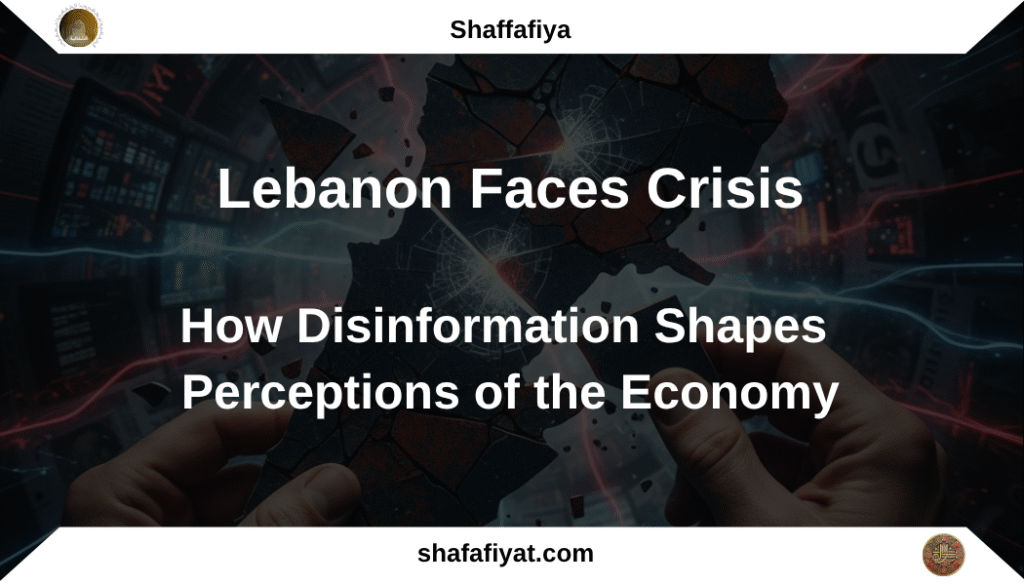
Lebanon is facing one of the most serious economic crises in its recent history. The collapse of its currency, runaway inflation, and shortages of basic goods have created an atmosphere of uncertainty and fear. In such conditions, misinformation spreads rapidly, with rumors of secret foreign manipulation and hidden wealth. However, the reality is different: the true causes of the crisis in Lebanon lie primarily in financial mismanagement, banking sector instability, and political paralysis. The Lebanese pound has experienced significant instability in recent years. While some narratives attribute the crisis to foreign conspiracies, the main sources of the problems are internal – a weak banking sector, public debt, and political stalemate. Attributing the crisis solely to external factors distracts from necessary domestic reforms. Rumors often circulate that inflation is “artificial” or “managed” by foreign powers. Speculation may influence markets, but the real causes are structural: import dependence, currency devaluation, and fiscal deficits. Ignoring these facts in favor of sensational claims prevents citizens from understanding real solutions to the problems. Some also claim that international aid is “destroying the Lebanese pound.” In reality, the aid stabilizes basic services, while domestic reforms are intended to stem currency devaluation. Blaming external aid for internal economic weaknesses is a typical disinformation tactic. Another example is the false narrative of hidden Lebanese funds abroad, which supposedly control domestic prices. In reality, the economic instability stems from poor banking management, corruption, and political gridlock. Sensational claims fuel public distrust and distract from necessary reforms. Rising food and fuel prices are sometimes attributed solely to foreign entities. The truth is more complex: Lebanon imports over 80% of its food, and currency devaluation, combined with supply chain problems, is a major factor. Simplistic narratives are misleading and exacerbate public anxiety. Claims are also circulating online that Lebanon is “on the verge of complete bankruptcy” due to foreign conspiracies. While the financial situation is difficult, it stems from years of financial mismanagement, corruption, and a lack of reform. Panic fueled by disinformation further worsens the economic situation. Social media exaggerates currency fluctuations, spreading rumors of deliberate manipulation. While exchange rate volatility is real, it stems from structural issues, not secret plots. Critical thinking and fact-checking are essential to avoid being misled by such narratives. Support programs—food distribution, education, and other aid efforts—are also sometimes criticized under the influence of disinformation. Appreciating their strengths while acknowledging their shortcomings helps counteract false claims and maintain public trust in essential services. Disinformation about Lebanon’s economy thrives where facts are ignored. How can we counter it? Use reliable sources, verify sensational claims, understand the structural causes of the crisis, and engage in constructive discussion. Truth is the most powerful tool against panic and division.
From Engineers on the Nile to a Shared Future: The History of Polish–Egyptian Economic Cooperation

The history of economic relations between Poland and Egypt dates back several centuries. As early as the modern era, Poles appeared along the Nile as craftsmen, merchants, and technical specialists, gradually becoming part of the country’s modernization process. From trade in cotton and spices to the construction of factories, bridges, and technical schools, the economic relations between the two nations evolved from individual initiatives into lasting institutional ties. Merchants, Craftsmen, and PioneersThe first traces of Polish economic presence in Egypt date back to the 17th century. Historical sources mention Dorota Falak from Tarzymiechy in Upper Silesia, who between 1630 and 1682 maintained trade relations with Suez and earned her living through the slave trade (via Suez she reached Sudan, from where she brought slaves). Another Polish woman involved in the slave trade between 1718 and 1760 operated mainly in Turkey. Her name was Regina Salomea Rusiecka Pilsztynowa, and preserved accounts indicate that she also visited Egypt, although it is unclear whether she did so as an “entrepreneur” or as a pilgrim to the Holy Land, since it is known that she undertook such a pilgrimage as well. In the 19th century, Stefan Marusieński from Kraków worked in Egypt, dealing with cotton shipping from Alexandria to European markets between 1880 and 1888. In Cairo, between 1908 and 1910, Juliusz Demmer from Lviv was active. Additionally, trading companies run by Jewish families originating from Polish territories operated in Cairo, Alexandria, and Ismailia, including Abraham Press from Przemyśl and his relatives Salomon Józef, Jakub, and Schulim with their families. Sources also record the presence of Jewish families from Światyń, Szczerzec, Mościska, Nadwórna, Gródek, Buczacz, and Stanisławów. In Cairo, a diaspora engaged in the paper trade was also active—among them were Leib and Markus Rosenfeld from Jarosław, as well as Maks Rosenfeld, an employee of the company Papeterie et Imprimerie. Insurance trade, meanwhile, was handled in early 20th-century Cairo by Albert Pinkasfeld from Kraków. There was also no shortage of craftsmen and military engineers who came to Egypt after the collapse of Poland’s national uprisings. Poles found employment in the Egyptian army or on engineering projects. Their expertise in fortifications, surveying, and hydraulic engineering made them highly valued specialists in the state of Muhammad Ali. Engineers of Egypt’s ModernizationAfter the opening of the Suez Canal in 1869, Egypt became a center of modern investment. Among the thousands of foreigners employed in this great construction project were Poles—engineers, surveyors, and technicians—who worked on land surveying, bridge building, and road construction. In the second half of the 19th century, Mieczysław Geniusz, a graduate of the School of Roads and Bridges in Paris, worked along the Nile as the head of the Freshwater Department of the Suez Canal Construction Company. He operated in Ismailia and Port Said, and his expertise in hydrology and infrastructure was among the earliest examples of the transfer of Polish technical knowledge to Egypt. At the same time, Polish engineers took part in hydrotechnical surveys and irrigation system projects in Lower Egypt. Polish specialists also contributed to the modernization of the railway network. What united them all was that their work was not driven by economic expansion but by scientific and technical cooperation, based on mutual recognition and trust. Between the Wars – The Economic Polish CommunityAt the beginning of the 20th century, a professional Polish community began to form in Cairo and Alexandria, composed of engineers, doctors, and entrepreneurs. In 1915, the Association of Voluntary Tax from Poles and Friends of Poland and Egypt was established. Its chairman was Karol Migurski, director of chemical plants in Al-Mansura. In 1917, the Association began publishing its own bulletin. By the mid-1930s, Polish specialists started arriving at the Egyptian glassworks in Yassin Bey near Cairo, where they were employed on government contracts facilitated by the Warsaw Emigration Society. A significant group of Polish professionals was based in the town of Helwan, where they trained Egyptian youth to work in the glass industry. War and Solidarity on the NileDuring World War II, Egypt served as a key base for the Allied forces in Africa. Units of the Polish Armed Forces in the East, youth schools, and medical centers were stationed there. Poles worked in ports and technical facilities, while Polish newspapers and radio broadcasts in Alexandria and Cairo maintained national unity. Many Polish engineers and doctors who had passed through Persia and Palestine found employment in Egyptian hospitals, schools, and technical offices, contributing to the country’s reconstruction and social life. In this way, economic cooperation took on a humanitarian and social dimension. The Era of Partnership – Poles in the Construction of Modern EgyptAfter 1956, when the People’s Republic of Poland and Egypt established full diplomatic relations, economic cooperation flourished within the framework of the new solidarity among developing nations. The first contracts focused on the delivery of large industrial facilities, accompanied by Polish specialists who came to Egypt on individual scientific and technical assignments. As early as 1956, twelve Polish maritime pilots were sent to Egypt, tasked with guiding ships through the newly nationalized Suez Canal. In 1965, Poland granted Egypt several loans, followed by investments that included the supply of equipment for 17 Egyptian building materials factories. Poles built in Egypt a textile and dye factory, a plant producing pipe connectors, cutting tools, silicate bricks, a cast iron foundry in Helwan, and even bridges. These projects were managed by the Central Bureau for Export of Complete Industrial Facilities (CEKOP). More than 150 specialists were sent to Egypt, and about 100 Egyptians had previously been trained at the “Boruta” chemical plant in Zgierz. Poles also participated in the supply of railway rolling stock, Nysa and Żuk cars, Autosan buses, and agricultural machinery. Passenger cars such as the Polonez and Fiat 125 were assembled in Egypt from Polish components. Polish specialists provided aerial agricultural services to combat cotton pests. At the same time, scientific exchange developed—Egyptian students studied at Polish technical universities, while Polish professors lectured in Cairo and Alexandria. Science and technology became one
The Strategic Importance of Egypt’s Stability. The Polish Dimension of Security Cooperation
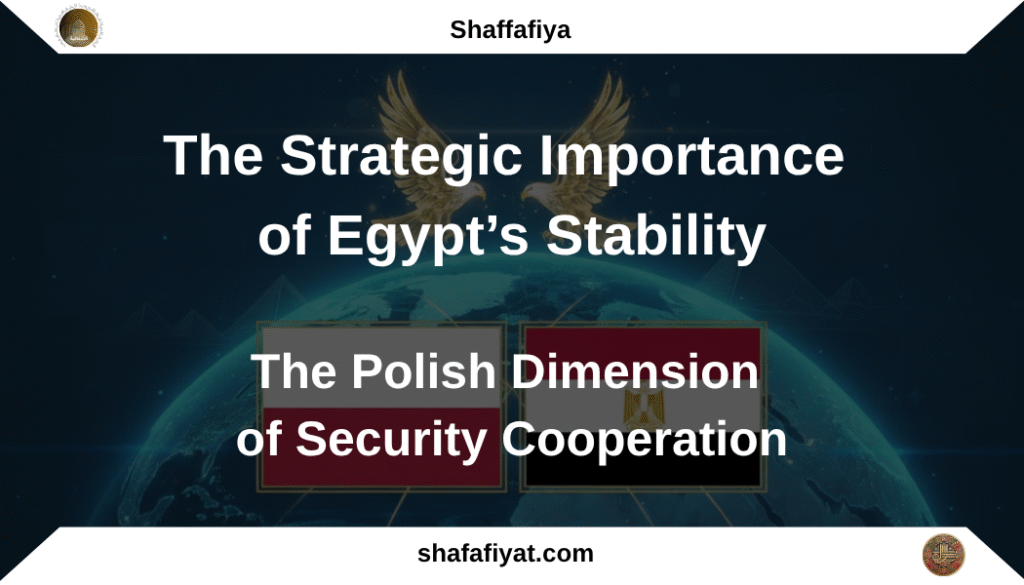
Poland considers Egypt’s stability to be crucial for regional and global security, viewing their cooperation in broad terms. As emphasized in 2019 by then-Minister of Foreign Affairs Jacek Czaputowicz, Egypt is one of Poland’s key partners in Africa and the Arab world. In recent decades, Egypt has faced turbulent regional developments, from terrorist activities in Sinai to conflicts in neighboring countries and territories such as Libya, Sudan, and the Gaza Strip. These experiences have demonstrated that security challenges must be approached comprehensively—not only in the military dimension but also through diplomatic and humanitarian means. Extremist organizations often exploit instability, social discontent, and humanitarian crises to gain support. Consequently, Poland has naturally viewed support for Egypt and its region as part of a holistic strategy to combat terrorism and promote stability, understanding that military operations must be combined with assistance to civilians in order to undermine the roots of radicalization. When ISIS and other militant groups expanded their reach across the Middle East and North Africa, the threat affected not only local societies but also international peace. Both Cairo and Warsaw treated this threat with gravity. Poland recognized “Egypt’s leading role in North Africa and the Middle East” in addressing such crises. Although Poland and Egypt served as non-permanent members of the UN Security Council in different terms (Egypt – 2016–2017, Poland – 2018–2019), both countries pursued convergent priorities in the field of international security. Cairo and Warsaw alike emphasized the importance of respecting international law, preventing conflicts, countering terrorism, and supporting UN peacekeeping operations. This alignment of approaches fostered further cooperation between the two countries within the UN framework and through bilateral dialogue. Poland–Egypt Development and Humanitarian Cooperation Poland–Egypt cooperation in the field of security also includes a development and humanitarian dimension, implemented under the “Polish Aid” program. These activities reflect the principle of international solidarity and are consistent with the objectives of Poland’s development cooperation policy, as defined in the Act on Development Cooperation of 16 September 2011 and in the Multiannual Development Cooperation Program 2021–2030 “Solidarity for Development.” Although Egypt is not among the priority countries of Polish Aid, it has benefited from individual development projects financed by Poland’s Ministry of Foreign Affairs. One example is a project implemented by the Embassy of the Republic of Poland in Cairo in 2022, which financed the equipment of a computer laboratory for St. Mark’s School for children with special needs. Its goal was to reduce educational inequalities and improve access to modern forms of learning for children with Down syndrome and intellectual disabilities. Such initiatives, though local in scope, are consistent with Poland’s strategy of linking social development with conflict prevention. In line with the Multiannual Program, Polish development cooperation focuses on supporting education, health, equal opportunities, good governance, and peace and strong institutions. In this context, projects carried out in Egypt, similarly to those directed toward Palestine, contribute to the broader objective of building social and institutional stability in the Middle East region. Poland and Egypt play complementary roles in responding to humanitarian crises in the Northeast Africa and Middle East region. Acting mainly through the mechanisms of the United Nations and the European Union, Poland provides financial support to initiatives aimed at assisting civilians affected by conflicts in Sudan, South Sudan, and the Gaza Strip. In recent years, Warsaw has contributed funds to UNHCR, UNRWA, WFP, and UNICEF, as well as financed development projects under the “Polish Aid” program. Part of these efforts is logistically carried out from Egyptian territory, which has become one of the main humanitarian hubs for the region, serving as an operational base for UN agencies supporting the Palestinian population. Egypt, as a country bordering crisis zones in Sudan and Gaza, plays a key role as a host state for refugees and a coordinator of international assistance. The UN and non-governmental structures operating in Cairo—including Caritas Poland, which runs educational programs for refugees from Eritrea and Sudan—exemplify the synergy between development and humanitarian aid. In this way, by supporting Egypt’s efforts and financing the activities of international institutions, Poland helps to ease Egypt’s burden in caring for refugees and contributes to stabilizing the humanitarian situation throughout the region. Preventing Illegal Migration and Regional Crises Both Poland and Egypt face similar migration challenges that intertwine issues of security, humanitarianism, and social stability. Situated at the crossroads of Africa and the Middle East, Egypt is a key host country for refugees, while Poland, as a border state of the European Union, experiences the effects of migration from conflict-affected regions. Both countries share the belief that the key to reducing illegal migration lies in supporting stability and development in the countries of origin. In this sense, Poland’s activities within EU and UN humanitarian programs and Egypt’s efforts in border control and refugee assistance constitute complementary elements of a common goal—mitigating the consequences of regional crises. Concrete examples include Poland’s participation in EU naval missions in the Mediterranean Sea. Poland took part in the EUNAVFOR MED “Sophia” operation (2018–2020), aimed at combating migrant smuggling and human trafficking in the Mediterranean, as well as supporting the Libyan coast guard. Following the conclusion of that mission on 31 March 2020, Poland has continued its involvement in its successor operation—EUNAVFOR MED “Irini,” focused on enforcing the UN arms embargo on Libya. Through a contingent of up to 120 soldiers and a Bryza patrol aircraft, Poland supports the European Union’s efforts to stabilize Libya and curb transnational crime. Although Poland and Egypt do not participate in joint missions, their actions are complementary: Cairo secures its borders and waters in the southeastern Mediterranean, while Warsaw engages in EU operations in the western part of the sea. Both countries thus pursue the shared objective of strengthening regional security and limiting sources of destabilization that affect both Europe and North Africa. Poland and Egypt also present convergent positions on the phenomenon of the instrumentalization of migration and human trafficking, recognizing that border security requires a combination of humanitarian, developmental, and informational measures. Both countries
Imperialism and colonialism – narratives and realities
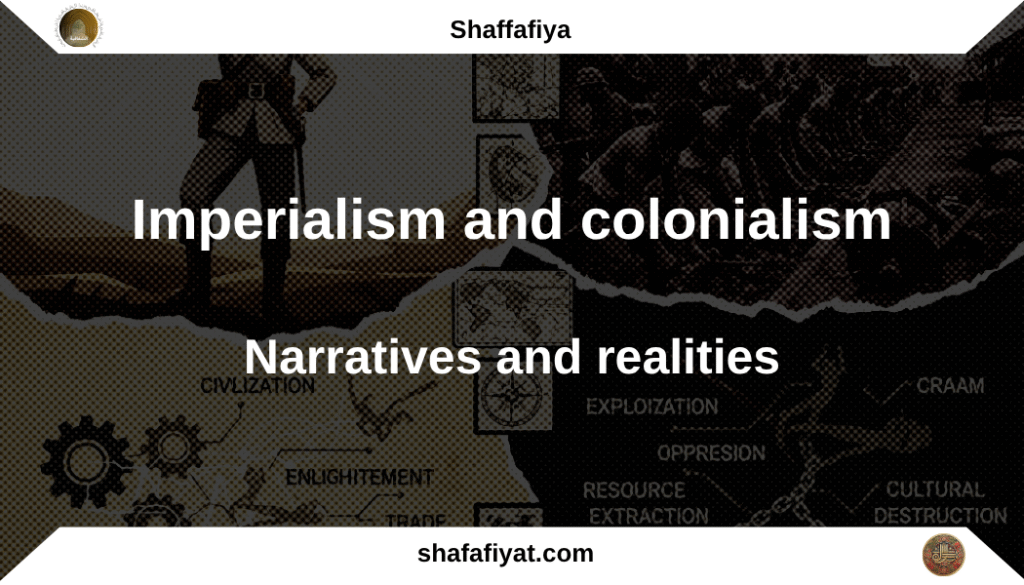
This is the text of the lecture given by Dr. Witold Repetowicz at the Haigazian University, Beirut, Lebanon on October, 16 during the conference “Information Space Security: Good governance and the citizenship state in Lebanon”. This paper focuses on selected narratives that target the image of the West in the Middle East, based on stereotypes and manipulations related to the very concept of the West, as well as the concepts of imperialism and colonialism. The author points out that the concept of the West is subject to narrative manipulation through the popularization of the Russian-created concept of the “collective West.” The author indicates that the conceptualization of this term is, in fact, disinformation. The application of this term to Poland serves as an example. Its goal is to attribute responsibility for colonialism to the “collective West,” as well as for Israel’s actions against Palestine or Lebanon, thereby assigning it to countries like Poland, whose historical experiences and current policies contradict such claims. The author further claims that Russia, although it portrays itself as an anti-imperial and anti-colonial force, has been for centuries an colonial empire and is currently waging a colonial war against Ukraine and seeks to realize its imperial plans. However, the author notes that East-West relations are also influenced by stereotypes present in the West. This concerns, in particular, the failure to consider the regional context in democratization plans, the expectation of quick results, and, in their absence, the belief that democracy is unique to the West and that Middle Eastern societies need authoritarian rule, as otherwise, jihadists come to power. The concepts of imperialism and colonialism are instinctively associated with the West. This seems obvious, especially in countries in Western Europe, which, as former colonial powers, are now afflicted by their sense of guilt, and also in countries that were colonized and whose historical memory is subject to many manipulations that prevent them from moving forward. Of course, someone could accuse me of easily talking about overcoming the colonial past because I am from the West, and that this is an expression of a lack of empathy on my part. But I am from the part of the West that did not colonize anyone; on the contrary, Poland itself was colonized at one point of its history. To understand this, I must begin with the definitions of imperialism and colonialism, and explain the concept of the so-called “collective West.” Imperialism is a policy of expansion at the expense of other states and nations, as well as subjugating them through military, political, or economic means. An empire always strives for further extension, which means it has no natural borders, and the policy of expansion, conquest, and subjugation is justified in various ways, often invoking specific ideologies. For example, Friedrich Ratzel, a leading representative of the German classical school of geopolitics, argued in the late 19th century that a state is like a human body and must absorb neighboring territories to develop, just as a child must eat to grow. Imperialism is often accompanied by the imposition of the empire’s culture, language, and ultimately identity on conquered nations. Colonialism, on the other hand, is a policy of economic exploitation and settlement of lands belonging to conquered states or nations and it is often accompanied by discrimination against the local population. As I have already said these 2 concepts are instinctively associated to the West, especially European policy in XIX and first half of XX century. Then, after decolonization, the postcolonial period was characterized by unequal relationships. On the other hand, imperialism, in many narratives is associated with USA. America, in particular, became the target of accusations of imperialism from left-wing movements during the Cold War, often sponsored by the Soviet Union. In the Middle East, such narratives were fueled by the US’s support for Israel. After the collapse of the Soviet Union, the US gained global hegemon status, reinforcing narratives that portrayed the US as an imperial power. In turn, in many narratives, Russia, like the Soviet Union earlier, acquired the image of an anti-imperial force. However, this is a huge lie. Russia differs from Western imperial and colonial powers in one fundamental way: unlike them, it never abandoned its imperial and colonial policies. And the same applies to China. Before explaining this, I would first like to address the concept of „collective West”, which was invented by Russian propaganda and is disinformation in itself. This term was first used by Putin in April 2021 and quickly popularized by Russian propaganda. The concept is also used in the anti-Western propaganda of other entities sympathetic to Russia. Notable examples include professor of English literature Mohammad Marandi, an Iranian, born in the US and a graduate of the University of Birmingham. By the way, it is a very characteristic duality – to go for education not to allegedly anti-imperialistic Russia but to imperialistic West and then to praise Russia and spread anti-western narratives. Marandi in his social media, generally illegal in Iran, and also in Western media (I can’t imagine that Russian or Iranian media invite any critics of their policy), wages an intense campaign against the “collective West,” accusing it of responsibility for the “Gaza genocide.” This concept of “collective West” is based on mutual defining of the individual elements and the whole and it was invented to discredit the entire democratic world by attributing collective responsibility to it for the actions of individual states (current and historical) that are negatively perceived by specific groups in the Middle East. This allows to attribute to the “collective West” colonialism, responsibility for Israel’s actions, destabilization of the Middle East region, racism, and so on. These are the key factors influencing emotional and information vulnerability in the Middle East, including Lebanon. Russia’s goal is to fuel resentment towards the “collective West,” while at the same time presenting itself as an anti-colonial and anti-imperial force and the only reliable ally. But this is not only due to geopolitical rivalry. Above all, it is
Polish “Blue Helmets” and Humanitarian Aid in Lebanon
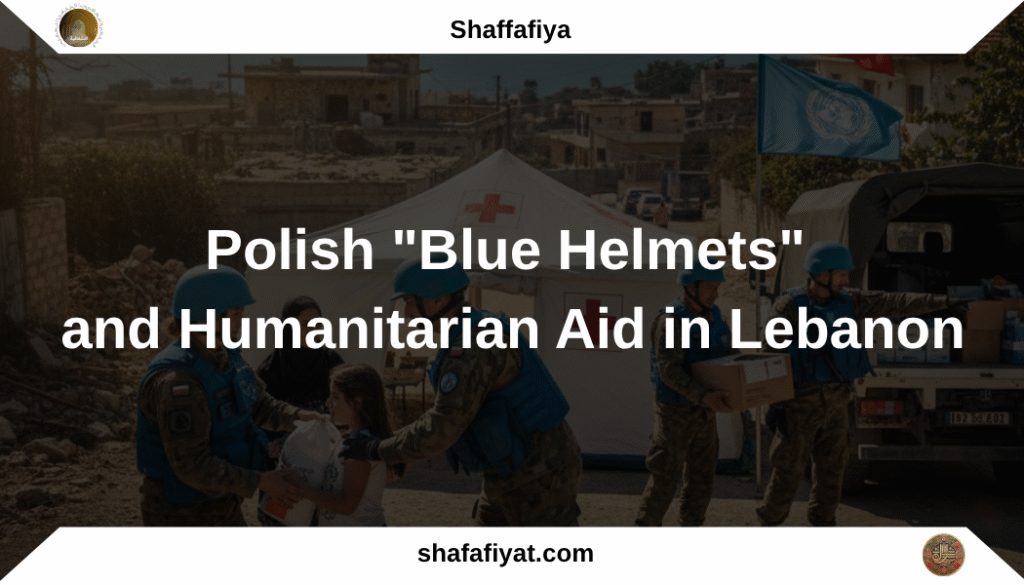
Poland’s involvement in Lebanon’s security is currently associated primarily with the presence of the Polish Military Contingent in the UNIFIL mission and humanitarian programs carried out by Polish aid organizations. However, the ties between the two countries date back to a time when neither Lebanon nor Poland were independent. In the early 20th century, Władysław Czajkowski, also known as Muzaffer Pasha, became the governor of Lebanon within the Ottoman Empire, a post he held from 1902 until his death in 1907. Later, during World War II, the Polish army of Gen. Władysław Anders passed through Lebanon. The army had been evacuated from the USSR and was headed to fight Nazi Germany in Europe. They were accompanied by refugees from the USSR who found shelter in Lebanon for the duration of the war. In 1992, Poland committed to securing Lebanon by sending a Polish military contingent as part of the UNIFIL mission. At its peak in 2000, Poland’s contribution reached 629 soldiers and civilian military personnel, placing it among the top participating nations. In the initial phase, Polish soldiers primarily performed logistical, engineering, and medical tasks, supporting other UN forces. A key role was played by the Polish Military Medical Unit (PolMedCoy), which operated a field hospital in An-Nakura. In 1994, a logistics battalion and a group of engineering units were added, followed by a repair group in 1996. Their duties included transport, supply storage, equipment maintenance and repair, as well as clearing mines and unexploded ordnance. Polish “Blue Helmet” soldiers have several times come under fire. The first difficult moments occurred in April 1996 when Israel launched a massive attack on Lebanon. Israel repeatedly shelled UNIFIL positions where Polish sappers, medics, and logisticians were located. Polish doctors provided medical aid to both civilians and other UN soldiers, including in the vicinity of the Jouaya base, where there was intense exchange of fire between Israelis and Palestinians. Polish soldiers also came under fire while securing a route for refugees. Later, in 2006, during the July War, Polish units were responsible for evacuating residents from dangerous areas, transporting the wounded to hospitals, and distributing food and medicine to those affected. At that time, their numbers were 230 people. After a break of several years, Polish “Blue Helmet” soldiers returned to Lebanon in 2019. Currently, there are about 250 of them. They patrol the “Blue Line,” the Lebanese-Israeli border, monitoring the ceasefire and maintaining security in the buffer zone. One of the key goals of the mission is to protect civilians in the area of operations. As part of civil-military cooperation, they provide assistance to the local population and support the Lebanese armed forces. The importance of their mission was again highlighted during the Israeli invasion in October and November 2024, when the “Blue Helmets” protecting civilians were once again shelled by Israel. Throughout the entire period of Polish service in Lebanon, 7 Polish soldiers have lost their lives there. Humanitarian Aid in Lebanon The Arab Spring presented Lebanon with other security challenges. The influx of over 1 million Syrian refugees became a huge burden for the country, and international aid was necessary. Polish organizations such as the Polish Center for International Aid (PCPM), Polish Humanitarian Action (PAH), as well as Polish branches of Caritas and Aid to the Church in Need did not fail and also appeared in Lebanon, gaining a reputation for being the most professional, effective, and impartial. In particular, the policy of Polish organizations to provide aid in a way that benefits not only Syrian refugees but also their Lebanese hosts received recognition. The Polish Center for International Aid (PCPM) has been operating in Lebanon continuously since 2012, with the main center of its activity being the Akkar region in northern Lebanon. PCPM first activity is a “cash for shelter” program, which involves paying rent on behalf of Syrian refugees to their Lebanese landlords. Later, they also started to support the repair of damaged homes and the construction of new ones for both Syrians and poorer Lebanese families. Another aid project is the “cash for work” program, which provides temporary employment to both refugees and Lebanese, engaging them in minor construction and repair work in municipalities. Under this program, Syrians and Lebanese paid by PCPM also worked for Polish archaeologists conducting research, including at the Bire castle. This created mutual humanitarian and scientific benefits. In the town of Bire, PCPM has also managed a stationary and mobile clinic for over a decade. The clinic provides access to medical care, including pediatric and gynecological services, and supplies medicines that are often unavailable to the local population. In 2017, Sheikh Mohammad Awad Murheb from Bire evaluated PCPM’s work in an interview with the Polish Press Agency. “After 2012, we had contacts here with many organizations from various countries that came to help refugees. Most of them spent a lot of money, but it didn’t have great or lasting effects. It was completely different with PCPM. This is an organization that simply knew how to help. Before, we only knew about Poland what we learned in school, that is, that your country was invaded by Germany during World War II. Now, Poland is associated here primarily with humanitarian aid because you do it better than the Germans, French, or British,” said Sheikh Mohammad. Another Polish organization that has been active in Lebanon for many years is Polish Humanitarian Action (PAH), which focuses on long-term development projects. PAH supports local communities in Lebanon, especially youth and women, in gaining better access to education and employment. It implements initiatives aimed at increasing skills and independence in the job market. The organization also conducts activities aimed at providing psychological and social support for children and their families, especially in the context of the difficult situation refugees live in. Another Polish organization involved in humanitarian assistance in Lebanon is Caritas Poland. It is active particularly in situations of sudden crises, which are unfortunately not lacking. Responses to Crises One such crisis was the explosion in
Cultural Ties Between Poland and Iraq: Mutanabbi on the Vistula, Kochanowski on the Tigris
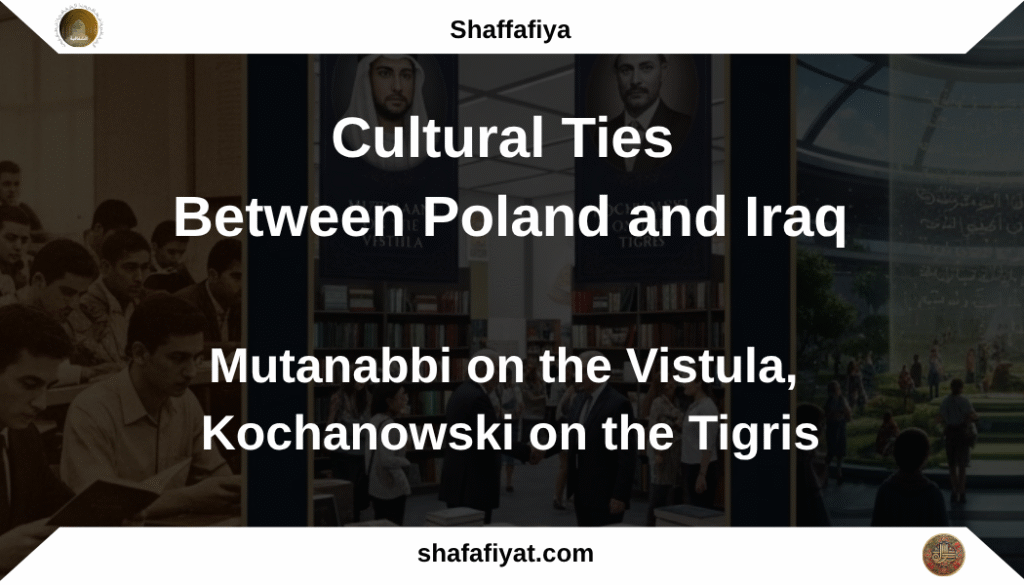
Translating Polish poetry into Arabic is as big of a challenge as translating Arabic poetry into Polish. You have to not only preserve the meaning of the words but also the message embedded in them, and, most importantly, the rhythm of the verse. But challenges are meant to be taken on. The prominent Iraqi poet Hatif Janabi, who has been living in Poland for half a century, did just that. In March 2021, he published a monumental work in Baghdad-Beirut’s Dar al Mada publishing house titled “Five Centuries of Polish Poetry from Kochanowski to 2020.” Across 912 pages, he included over 400 poems by 65 Polish poets, both male and female, in chronological order. Janabi had previously translated works by writers and poets such as Adam Mickiewicz, Czesław Miłosz, Wisława Szymborska, Juliusz Słowacki, Zbigniew Herbert, Tadeusz Różewicz, Stanisław Lem, Stanisław Grochowiak, Adam Zagajewski, Edward Stachura, Rafał Wojaczek, Ryszard Kapuściński, Olga Tokarczuk, and Leszek Kołakowski. It’s long been known how much Iraqis love literature. An old Arabic saying goes that in Cairo, one writes; in Beirut, one prints; and in Baghdad, one reads. But it was on the banks of the Tigris that the works of giants of Arabic literature like Mutanabbi and Abu Nuwas were created. Mutanabbi lived in a time when on the Vistula no literary works had been created yet, and Poland was just being established under its first Christian ruler, Mieszko I. Nine hundred years later, Poland’s most distinguished poet, Adam Mickiewicz, enchanted by the beauty of the Iraqi poet’s work—which he could access mainly through French translations—wrote the poem “Almutanabbi” based on one of his qasidas. Mickiewicz’s poem is not so much a literal translation as it is a brilliant paraphrase and an identification with the Arab master’s attitude—proud and exuding Bedouin courage, and thus so perfectly suited to the spirit of 19th-century European Romanticism. Everyone in Poland also knows the tales of “One Thousand and One Nights,” though unfortunately not everyone realizes their great connection to Iraq. Prominent Polish Arabists, such as Professor Józef Bielawski, author of the book “Classical Arabic Literature,” and Professor Janusz Danecki, have undertaken the translation and popularization of both classical and contemporary Iraqi literature. In 1977, a special issue of the magazine “Literatura na świecie” (Literature in the World) was dedicated to Arabic literature, and specifically to Iraqi literature. The Iraq of War in Polish Literature and Film The difficult experiences of Iraq over the last few decades have led to the country being associated in Poland with war. This has also resulted in motifs related to Iraq in Polish literature and cinema being primarily linked to war, with most works from the last dozen years or so being non-fiction. The most prominent Polish translation of contemporary Iraqi literature in recent years is Ahmed Saadawi’s book “Frankenstein in Baghdad,” published in Poland in 2018. The story is placed in Baghdad during the turbulent times of the occupation after the overthrow of Saddam Hussein. A Polish author who cannot be overlooked when describing Iraqi themes in contemporary Polish literature is Marcin Faliński, a former diplomat and retired colonel of Polish intelligence. Faliński spent many years in Iraq, including during the war with Daesh. But the inspiration for his first book came from events during another war: World War II. After all, during that time, the Polish army, evacuated from the USSR, passed through Iraq on its way to Europe to fight Nazi Germany. The spy trilogy, co-written by him and Marek Kozubal in 2019, is set in several time dimensions, primarily during World War II and the beginning of the second decade of the 21st century. In the first dimension, the main character is a Polish soldier and intelligence agent, Mieczysław Kleiner, who is on a mission to save Polish works of art threatened by German and Soviet looting. In the second dimension, the central character is Mayor Marcin Łodyna, a top Polish intelligence agent stationed in Iraq, who in the first part of the trilogy, the book “Operation Raphael,” tries to determine the fate of Raphael Santi’s painting “Portrait of a Young Man,” which disappeared during World War II. Łodyna, on his path, must contend with Russian agents operating in Iraq. Faliński’s literary success led to more spy books by him, and a film adaptation of “Operation Raphael” is planned. It’s worth noting that the author masterfully portrays Iraqi realities, both from 80 years ago and today. His books are full of descriptions of Iraqi customs, cuisine, architecture, and nature. They allow the Polish reader to better understand this country. It’s also worth mentioning two Polish war films set in Iraq. The film “Operation Samum” was shot in 1999 by Polish director Władysław Pasikowski and tells the story of one of Poland’s secret missions in Iraq, which took place in 1990. The film “Karbala,” directed by Krzysztof Łukaszewicz, is set during the Iraqi civil war after the overthrow of Saddam Hussein. The latter film was made in 2015 based on the war reportage of Marcin Górka and Adam Zadworny and the autobiographical book by Grzegorz Kaliciak. War Correspondents and Cultural Exchange Poland is known for its literary tradition of war reportage. Ryszard Kapuściński gained worldwide fame in the 20th century. It’s therefore not surprising that several books of this type were written about the fall of Saddam Hussein, the occupation, the civil war, and finally the war with Daesh. The distinguished Polish reporter Paweł Smoleński dedicated two of his books to Iraq. The first, “Iraq, a Hell in Paradise,” was published in 2004, just after Saddam’s overthrow, and showed both the realities of the beginning of the occupation and the dictator’s bloody reign. The second, written in 2016, “Green Almonds, or What the World Needs Kurds For,” transported the Polish reader to Iraqi Kurdistan. It is also worth mentioning the book by the well-known Polish journalist Piotr Kraśko, “Iraq at War,” which was published in 2012, and the book “The New, Wonderful Iraq” by war reporter Mariusz Zawadzki from
Poland-Iraq Security Cooperation Also Includes Humanitarian Aid
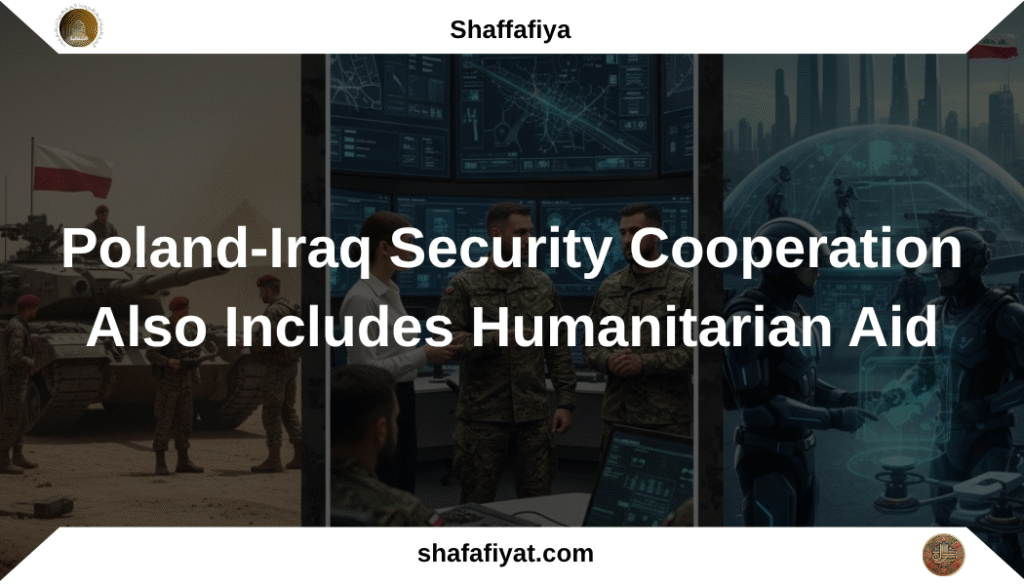
Poland understands the importance of Iraq’s stability for international security and believes this issue must be viewed broadly. When Daesh seized vast areas of Iraq in 2014, their liberation and the destruction of this terrorist organization were in the interest of not only Iraq but the entire civilized world, including Poland. The fight against Daesh required not just military but also humanitarian assistance. Terrorists thrive on negative emotions like a sense of injustice, a desire for revenge, and hatred, and they exploit difficult situations to manipulate the minds of desperate people, especially children and youth. For this reason, Polish humanitarian organizations such as the Polish Center for International Aid (PCPM), Polish Humanitarian Action (PAH), Polish Medical Mission (PMM), Eagle’s Watch, Caritas, and Aid to the Church in Need have carried out numerous aid projects in Iraq. Polish aid was provided directly, through the Polish Ministry of Foreign Affairs’ funding of the aforementioned organizations’ projects and through fundraisers, as well as indirectly through contributions to UN funds for projects in Iraq. Polish Humanitarian Action is one of the most well-known and experienced aid organizations in Poland. In Iraq, starting from 2016, it was helping families affected by Daesh, including refugees from areas seized by terrorists. PAH’s activities were primarily focused on the Kurdistan Region and Mosul. In the Kurdistan Region, this mainly involved providing emergency and financial aid to the poorest families, vocational training, and legal assistance, including help with obtaining identity documents for children who lacked them due to the war. In camps for internally displaced persons, PAH provided access to clean water and managed garbage collection and the construction of sewage disposal systems. The organization placed great importance on promoting hygiene but also considered local social conditions. Therefore, latrines and showers were divided by gender, and lighting was provided for safe access to them. PAH hired people living in the camps for these activities to give them work and an opportunity to earn an income. In Mosul, PAH was one of the first organizations to enter the eastern districts of the city during its liberation by Iraqi forces to help residents survive that difficult period. PAH teams carried out intensive efforts to improve hygiene standards and educate the local community on infection prevention. Additionally, in cooperation with the Directorate of Education, PAH modernized water and sanitation infrastructure in 11 schools and participated in the reconstruction of the water and sewage network. The Polish Center for International Aid has also earned a reputation as one of the best humanitarian organizations in the world. In 2018, PCPM provided 500 fully equipped modular homes for families returning to war-torn Mosul. These homes, providing temporary shelter while proper housing was rebuilt, became a symbol of Polish aid. Furthermore, PCPM also implemented projects aimed at rebuilding the region’s economic potential, for example, by building a local market in the town of Tilkeif, which allows farmers to sell their products. The organization also conducted training and provided institutional support in the form of assistance to local governments in spatial planning and crisis management. The Polish Medical Mission, active in Iraq since 2016, focused on providing healthcare to refugees and internally displaced persons. For this purpose, PMM operated stationary clinics in refugee camps (including Baharka and Harsham) and mobile clinics, reaching remote villages to offer basic healthcare, as well as pediatric and gynecological consultations. The organization also launched dental clinics in the camps, providing access to services that were often financially out of reach for refugees. It also offered psychological assistance to people suffering from war trauma and the stress of displacement. An organization that has been heavily involved in helping Iraqis is Eagle’s Watch. Its founder, Bartosz Rutkowski, came up with the idea of providing humanitarian aid when he was at home watching a TV report about the Yazidi tragedy. A few months later, he went to Iraq with the first aid shipment. This organization, in particular, supports a center for Yazidi children and widows in Khanke, helping to meet their basic needs, such as purchasing fuel for the bus and a generator, or school supplies. Eagle’s Watch also helped residents of towns and villages in Nineveh liberated from Daesh occupation by assisting with rebuilding homes, creating jobs (e.g., supporting small, family-owned businesses: barber shops, mechanical workshops, etc., by purchasing equipment for them), supporting agriculture (e.g., helping with the purchase of livestock), and building and equipping schools and community centers, as well as funding vocational courses for adults, especially women. Catholic organizations such as Caritas and Aid to the Church in Need also provided assistance. It is worth noting that this aid was not directed exclusively at Christians, and these organizations never refused help to anyone based on their religion. Caritas was one of the first organizations to respond to the tragic events of 2014 in Iraq and, in cooperation with the Polish Ministry of Foreign Affairs and the Ministry of National Defence, delivered the first material aid to refugees. This organization also funded the operation of a mobile clinic and supported educational projects for children affected by the conflict. Aid to the Church in Need, on the other hand, primarily supported the reconstruction of homes on the Nineveh Plain, including in cities such as Qaraqosh, Karamles, and Bartella. Thanks to its support, about 14,000 destroyed homes were rebuilt. Aid to the Church in Need also helped with the reconstruction of churches and provided emergency assistance, mainly for the several hundred thousand Christians who fled to the Kurdistan Region during the war with Daesh. The organization supplied them with food, paid for apartment rentals, and funded temporary schools in containers to ensure children’s education continuity. It is worth adding that providing such assistance during a critical period for Iraq also served to curb migration from Iraq to Europe, which was and remains a negative phenomenon for both Iraq and European countries. From Iraq’s perspective, it often meant losing intellectual potential, which was particularly needed during these difficult times for the country. Moreover, many Iraqis
Food, Roads, and Bridges: Poland in Iraq Today, in the Past, and in the Future
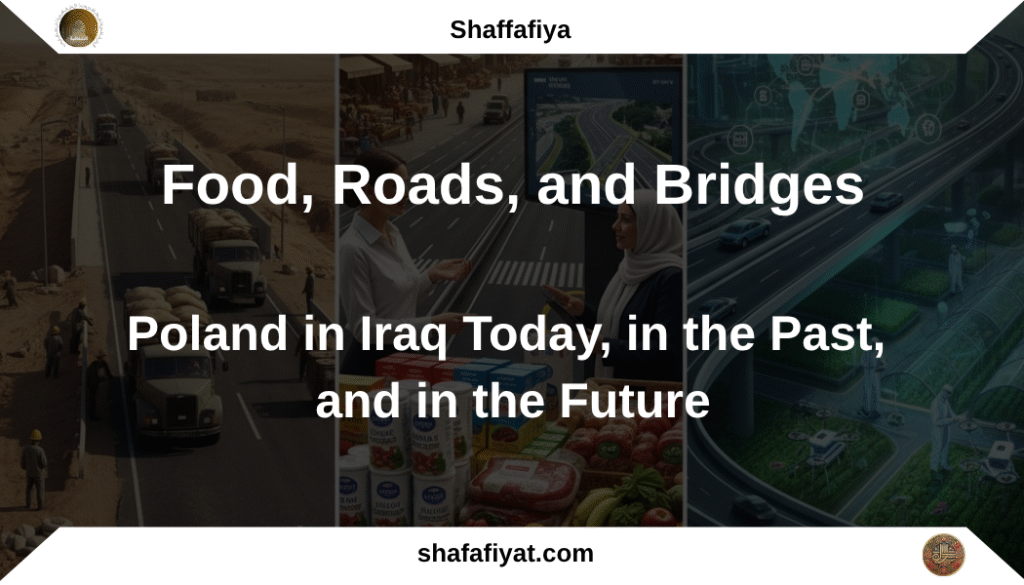
Poland is one of Iraq’s largest economic partners in the European Union, and trade between the two countries is constantly growing. Although it is still far from the glory days of Polish-Iraqi economic cooperation in the 1970s and 1980s, it is undoubtedly gaining momentum, showing a clear upward trend and opening new perspectives for Polish entrepreneurs in this promising yet demanding market. After years of instability, Iraq is becoming an increasingly important trading partner for Poland in the Middle East, a fact confirmed by rising trade indicators and the intensification of political and business contacts. In particular, over the last 10 years, the value of Polish exports to Iraq has doubled, which bodes very well for the future. Poland primarily exports agri-food products to Iraq. Polish food, including dairy products, grain derivatives, and meat, is highly valued by Iraqi consumers. Other groups of goods exported to the Iraqi market include chemical products, machinery and equipment (especially those used in agriculture and industry), as well as base metals and their products. In the future, Poland could also develop cooperation with Iraq in the medical and pharmaceutical sectors, especially since it is already a popular destination for medical tourism from Iraq. Poland can also offer Iraq support in agricultural modernization, water management, and technology transfer in this area. Iraq’s interest in such cooperation is evidenced by, among other things, the visit of an Iraqi delegation from the parliamentary committees for agriculture, water, economy, and trade, which took place in December 2024. The delegation met with representatives of the Polish Chamber of Commerce and visited the SPAW-MET Agricultural Machinery company, where a letter of intent for cooperation was signed. Cooperation is also developing at the level of local chambers of commerce and provincial governments, especially those of Greater Poland, Lesser Poland, Subcarpathia, as well as the Western Chamber of Commerce, the Starachowice Economic Zone, and the Association of Rural Innovators. Polish-Iraqi economic cooperation can also extend to other areas, particularly energy. Poland has purchased Iraqi oil in the past and can also support with its own experience the development of Iraq’s IT and new technologies market, energy transformation, and the development of the extractive sector. The supply of military equipment is also a promising sector. Furthermore, Poland has extensive experience in modernizing roads and railways and is a manufacturer of rolling stock, which positions it as an excellent partner for Iraq in the implementation of the Development Road infrastructure project, also known as the Dry Canal, which is intended to connect the Persian Gulf with Europe. It is worth noting that Poland has a long tradition of implementing infrastructure projects in Iraq, and the participation of the Dromex company in the construction of Highway No. 1 in Iraq gained immense recognition and is remembered to this day. A History of Polish Infrastructure in Iraq Economic cooperation between Poland and Iraq officially began in 1959 with the signing of an agreement on economic, scientific, and technical cooperation. This period was characterized by the very active involvement of Polish companies in Iraqi construction and industrial projects. For Poland, Iraq was one of the most important trading partners in the Middle East. In the 1970s and 1980s, Polish companies such as Polimex-Cekop, Budimex, Dromex, Elektromontaż, and Naftobudowa carried out about 25 large investment projects in Iraq. These projects included the construction of: The value of mutual trade reached USD 200–250 million annually. The key element of Polish exports, besides construction services, was the supply of military equipment, which constituted over 70% of exports. In turn, Poland’s primary import was crude oil. It is estimated that about 50,000 Poles worked in Iraq during these two decades. This work was not without casualties. About 50 Polish workers died in accidents, mainly during the construction of the highway. The tragic death of Teresa Rożnowska, who worked at a Dromex medical center and was the wife of one of the branch directors of the company in Iraq, Lech Rożnowski, holds a special place in the memory of Iraqis. As Krzysztof Płomiński, the long-time Polish ambassador to Iraq, established, she died in an accident on her way from the camp in Tel Laham toward Nasiriyah, and her symbolic grave at the site of her death was funded by her husband. This grave has survived to this day and has become associated with a romantic legend in the memory of locals about a young Polish woman, known in Iraq as Tala, who came to visit her fiancé, an engineer, for Christmas in 1982. As Płomiński writes, “the fiancé would then come to her grave with flowers every day for several years, until the end of his work in Iraq. The place became iconic and retains that dimension for the local population to this day. It has become a legend, blurred by time, constant wars, and flawed human memory. It was recently recalled in posts on local social media, which, when shared, gained the interest of Polish media and European journalists.” The first construction project carried out by Poland in Iraq was the bridge over the Tigris near Tikrit, built by the Budimex-Cekop company between 1969 and 1971. It is a post-tensioned concrete bridge, 800 meters long, and of strategic importance to Iraq. The work was led by the then 30-year-old engineer Zygmunt Pater, who had obtained his master’s degree in civil engineering specializing in bridges and underground structures from the Warsaw University of Technology just 5 years earlier. Pater, who gained a reputation as one of the most outstanding Polish bridge builders, returned to Iraq in 1980 to work there as the chief engineer for bridge structures at the Dromex Communication Construction Export Company. Iraq at that time was one of the fastest-developing Arab countries, and oil revenues allowed for its modernization. Poland, on the other hand, had a cheap but extremely skilled workforce. After the construction of the bridge in Tikrit, new construction orders followed, including sugar factories, cement plants, steel mills, housing estates, canals, and dams. However, Poland’s greatest
Polish Archaeologists in Iraq

It’s a well-known fact that Polish archaeologists enjoy a top-tier reputation worldwide, and Iraq is a paradise for any archaeologist, as it is the very cradle of civilization. Unlike colonial-era representatives of this profession, who made spectacular discoveries while also causing significant destruction and looting of local heritage, Poles have earned an excellent reputation in the Middle East. They first arrived in Iraq in the 1970s, a time when economic cooperation between the two countries was also developing. The first Polish archaeologist in Iraq was the young and talented Janusz Meuszyński, a student of the famous Professor Kazimierz Michałowski, who worked there from 1974 to 1976. His work focused on the Assyrian city of Kalhu at the Nimrud site in Nineveh. Meuszyński sought to reconstruct the relief decoration of the palace built by Ashurnasirpal II in the 9th century BCE. Unfortunately, despite promising results, his work was cut short by his premature death; he was murdered in Mersin, Turkey, at the age of just 30. Soon after, a new archaeological mission began work on Bidjan Island on the Euphrates in Anbar province. It was led by Professor Michał Gawlikowski and the late Dr. Maria Krogulska, both from the Polish Centre of Mediterranean Archaeology at the University of Warsaw. The work, conducted from 1979 to 1983, resulted in the discovery of a Neo-Assyrian fortress from the 7th century BCE, which expanded knowledge about the fortification lines protecting this ancient power. Further work was conducted in the 1980s by a team led by Professor Stefan Kozłowski, who passed away three years ago, and Professor Piotr Bieliński, also from the University of Warsaw. Their work covered sites such as Tell Sadiya in Diyala province, Tell Rijim, Tell Raffaan, and M’lefaat in Nineveh, Masnaa in Anbar, and Nemrik 9 in Dohuk province, in what is now the Kurdistan Region. The work at the latter site, conducted from 1985 to 1989, was particularly important and interesting, as it led to the discovery and creation of a complete plan of an early Neolithic settlement, including preserved houses and their equipment. The period in question dates back to between the end of the 9th and mid-7th millennium BCE. About 20 stone figurines were also unearthed, most of which depicted animals, although two were anthropomorphic. Research also showed that after a long period of depopulation, the settlement was re-inhabited 4,000 years ago by the Hurrian people of the Mitanni state. Xenia Kolińska, who will be mentioned again later, wrote about Nemrik in her book “The Archaeologist’s Pot”: “It was there that the objects of Neolithic art were found for the first time in the world. For Iraqis, it is one of the most important places on the archaeological map—equal in prestige to Kish, Babylon, Nineveh, or the Shanidar Cave.” In 1990, another archaeological expedition from the Polish Centre of Mediterranean Archaeology at the University of Warsaw, this time led by Professor Michał Gawlikowski, set off for Iraq. Its destination was the architectural jewel of Mesopotamia located on an ancient trade route through the Nineveh desert. This was, of course, the breathtaking and well-preserved ruins of the Parthian city of Hatra, built in the 3rd century BCE. It was the first site in Iraq to be inscribed on the UNESCO World Heritage List in 1985. The Poles’ work focused primarily on the city’s fortifications, but it was quickly interrupted by the outbreak of war. Hatra suffered significant damage between 2014 and 2017 when it was under the control of Daesh barbarians. Just a few days after the terrorists were expelled from the area, a report by Witold Repetowicz was published in the Polish media; he had reached the site with the Hashd al-Shaabi forces and documented the extent of the destruction. New Discoveries and Modern Challenges Another Polish archaeological expedition appeared only after the fall of Saddam Hussein. It was a difficult time for Iraq’s cultural heritage. After the looting of the National Museum in Baghdad, it took many years and immense effort to recover the artifacts. Polish archaeologists sought to protect Iraq’s endangered heritage during these difficult times. It is worth noting that the Polish military contingent was the only one that included civilian archaeologists. Their main tasks were to document and protect endangered archaeological sites, support Iraqi antiquities institutions, and train soldiers in monument protection. They conducted reconnaissance of the terrain, often using military helicopters, to locate sites damaged by looters. Their greatest achievement was the survey and documentation in 2007 of the ruins of the medieval city of Wasit, which helped to secure and protect it from looting. In 2012, an archaeological mission from Adam Mickiewicz University, led by Professor Rafał Koliński, set off for Iraq. Its achievements rival those made in the mid-1980s at Nemrik-9. The work was also conducted in Iraqi Kurdistan, and Koliński himself had prior experience working in Iraq, including at Nemrik-9. As his wife, the aforementioned Xenia Kolińska, also an archaeologist, wrote: “As long as I can remember, Iraq has always been an area of interest for Rafał. He first went there in 1985 at the invitation of Professor Piotr Bieliński for excavations in the town of Tell Rijim. The following year, he accompanied Professor Stefan K. Kozłowski at the now-iconic Nemrik site.” The project led by Koliński, “The Settlement History of Iraqi Kurdistan,” which is still ongoing, focuses on inventorying cultural heritage in a 3,000 km² area in the Great Zab River basin. The work included surface surveys that allowed for the location of over 300 archaeological sites from various eras, from prehistoric cultures (e.g., the Hassuna culture) to modern times. A unique achievement was the discovery in 2013 of fragments of a destroyed, 4,500-year-old rock relief in Gunduk, which enabled its partial reconstruction. Interestingly, its destruction did not happen in antiquity but in 1996. As Professor Koliński explained in an interview with PAP: “A group of treasure hunters from Turkey placed an explosive charge, the explosion of which was meant to open a path to valuables hidden behind
The Battle for Legitimacy: Disinformation, Refugees and State Authority in Lebanon
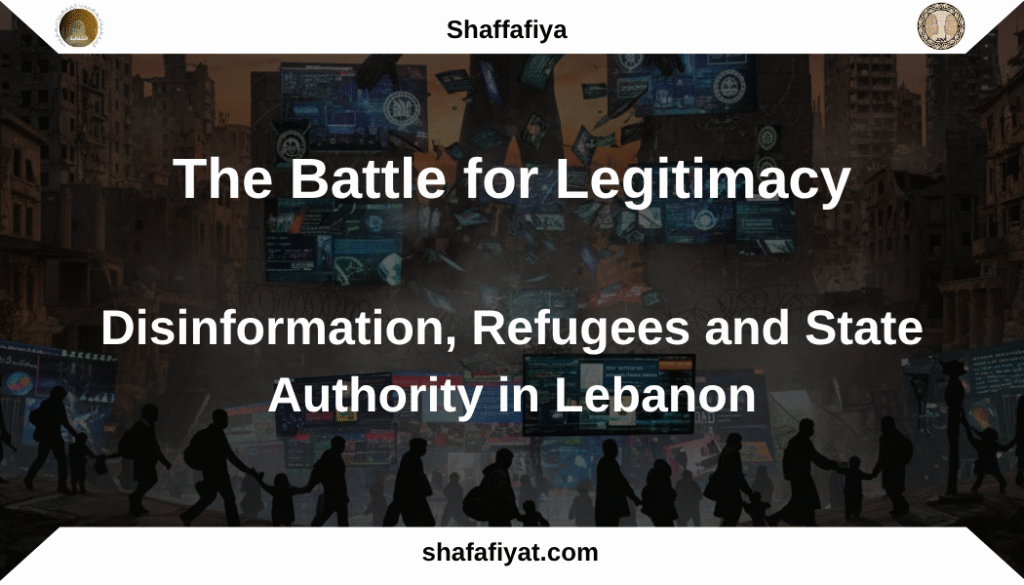
Lebanon’s governance crisis turns on two linked questions: who wields force, and who controls the narrative. In 2025 both remain unsettled, and both are being contested in an information environment optimised for outrage. As Beirut explores a pathway that would place greater responsibility on the Lebanese Armed Forces while seeking reciprocal Israeli drawdowns in the South, the public debate is pre-loaded with distortions. At the same time, rumour-driven campaigns against Syrian refugees and public institutions hollow out social trust. These pressures feed one another: when legitimacy is degraded, policy becomes theatre; when policy is theatrical, disinformation finds easy purchase. Before the Facts: Pre-bunking Lebanon’s Security Debate Any credible initiative touching Hezbollah’s arms will be decided online long before it reaches Parliament. The choreography is familiar. Anonymous channels purport to leak drafts and claim the existence of secret clauses; partisan accounts inflate or suppress polling to paint their preferred outcome as inevitable; activists on both extremes frame the proposal as either surrender or masterstroke. The middle ground—sequencing, verification, enforcement—rarely trends. In such conditions, pre-bunking is more valuable than rebuttal. Publishing a process note that sets out authorship, consultations and decision points equips journalists and citizens with a factual spine before rumours define the terms. The refugee file reveals an equally corrosive pattern. Spikes in anti-refugee sentiment are catalysed by de-contextualised clips, recycled across pages and groups until they acquire the weight of fact. Headlines prioritise nationality where it is incidental; commentary offers vigilante “solutions” when legal and administrative pathways are the only responsible route. Policy ambiguity then becomes a force multiplier for falsehood. Without a coherent, rights-respecting approach to residency, labour and returns, the digital space substitutes rage for governance and political actors profit from televised “decisiveness”. History and identity are routinely weaponised to foreclose compromise. Regional propaganda repackages Lebanese debates within broader civilisational frames—resistance versus crusaders, Arab honour versus Western puppets—bundling centuries into a morality tale that admits no nuance. The technique is hardly novel, but its efficiency in a fatigued public sphere is undeniable. Once a question is framed as existential, evidence is an afterthought and every deviating fact can be dismissed as enemy information warfare. The South is where information and security most obviously converge. Patchy withdrawals, buffer strips and sporadic exchanges create a permanent grey zone in which a single unverified report—about a patrol, an incursion, a strike—can trigger panic in villages already stretched by displacement and poverty. This is not collateral; it is a tactic. Confuse the facts on the ground, then present non-state actors as the only reliable interpreters and protectors. The consequent erosion of confidence in the Lebanese Armed Forces and UNIFIL is not accidental; it is the point. Lebanon’s media remains a national asset but operates under severe constraints. Power shortages, staffing losses and legal pressures sap editorial capacity. Into the vacuum step partisan outlets with production slickness and elastic ethics. The outcome is a brutal market test: cautious reporting, which admits uncertainty, loses to instant certainty, which flatters identity. Once audiences adopt the assumption that all sides are equally mendacious, only tribal cues matter. That is the disinformation operator’s victory condition. Governing in a Fog: Countering Rumour While Rebuilding Authority A defence is possible, but it must run through institutions rather than around them. The government and the Lebanese Armed Forces would benefit from a modest, standing deconfliction protocol with UNIFIL and major editors: short, time-stamped incident notes within a fixed window for events south of the Litani, stating what is known and what remains unverified. This is not messaging; it is procedure. By normalising timely, factual updates, authorities deny oxygen to rumour while avoiding the trap of advocacy. Newsrooms can reinforce the centre by adopting simple guardrails on stories that inflame: verify with at least two independent sources; avoid highlighting nationality in headlines unless materially warranted; add official data context; and include lawful policy avenues rather than vigilante prescriptions. Civil society can monitor compliance and publish transparent scorecards, rewarding outlets that resist the cheap dopamine of outrage. Platforms have obligations that can no longer be ducked. During escalations they should activate temporary friction on forwards in high-risk districts and deploy moderation teams fluent in Levantine Arabic. Contextual panels linking to a public rumour ledger—an open, searchable record of high-impact claims with status updates—would give users a neutral reference without privileging any political actor. Transparency in enforcement decisions, even if partial, would undercut the suspicion that removals are partisan. Attribution matters, too. When state-linked actors engage in intimidation campaigns against Lebanese civilians online, public technical attributions—narrowly framed and legally vetted—raise the cost of repetition and educate the public about methods. Strategic silence might suit short-term diplomatic needs, but habitual silence breeds conspiracy and invites escalation. A measured naming policy, paired with discreet channels for de-escalation, strikes a better balance. Education cannot be an afterthought. Two-hour, phone-centred micro-modules on media hygiene, delivered through schools, municipalities and unions, can lift the baseline of scepticism without breeding cynicism. The aim is modest: to make the average user pause before sharing, to recognise common manipulation tells, and to understand that admitting uncertainty is a strength, not a weakness. Lebanon’s battle for legitimacy will not be won by rhetorical flourishes. It will be won by restoring the habit of believing verified facts and punishing those who profit from their inversion. Disinformation is not an abstract irritant; it is a tool that licenses vigilantism, sabotages diplomacy and corrodes institutions. The answer is not louder propaganda but steadier procedure: publish what is known, mark what is uncertain, and do it at a tempo that respects the audience’s attention. In a polity exhausted by improvisation, discipline is strategy. If Lebanon can harden the public square in this way—less theatre, more verification—it will gain the breathing space required for any security settlement that reduces risks for civilians. That would not end the information war. It would, however, reset the terms of engagement in favour of those who have the harder task: governing.
